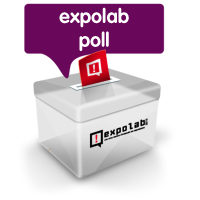|
|
 Today, The Tech Museum president, Dr. Peter Friess, officialy opened the exhibition “The Tech Challenge Gallrey”. This exhibition shows to new visitors, more than forty totally interactive experiments prepared, narrated and explained by other visitors: boys and girls that have collaborated in this gallery explaining experiments on video. Today, The Tech Museum president, Dr. Peter Friess, officialy opened the exhibition “The Tech Challenge Gallrey”. This exhibition shows to new visitors, more than forty totally interactive experiments prepared, narrated and explained by other visitors: boys and girls that have collaborated in this gallery explaining experiments on video.
This exhibition has been and is a learning process for all. On the one hand, kids close to the Tech Museum have learned by getting involved in the exhibition creation process itself. They also have discovered fundamental laws of physics related to light, mechanics, fluids and then have been able to explain them in their own words in a simple, funny and engaging language. They are the protagonists of it all. They appear on a video seen on a flat screen device behind an actual physical experiment that can be use in the gallery.
On the other hand, the Tech Museum professionals have been able to learn more things by sharing with this true protagonists of the museum and they have been able to share this experience with this special visitors. The President of the Tech Museum said that there is no better way to measure the impact of the Museum than to see how this kids are explaining scientific laws and experiments. It is a way of measuring not so much related to quantities of visitor but to the quality of their learning.
 Finally, other new visitors will be able to experiment and understand science thanks to the videos recorded by other previous visitors: the girls and boys we have alreadya mentioned. Everyone, eventually could become the start of the “Tech Challenge Gallery”, because this is a process that is alive and well and will be kept going by all people involve, staff and visitors alike. Finally, other new visitors will be able to experiment and understand science thanks to the videos recorded by other previous visitors: the girls and boys we have alreadya mentioned. Everyone, eventually could become the start of the “Tech Challenge Gallery”, because this is a process that is alive and well and will be kept going by all people involve, staff and visitors alike.
The Tech Museum will create a new lab, where boys and girls will be able to shoot their own videos explaining what they have learned while performing experiments and other activities in the center.
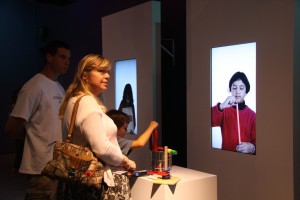 This exhibition, however, is not only for kids. Adults can also enjoy it. The Expolab Team (Irene Lapuente and Ramon Sangüesa) have been there too and enjoyed playing with wheel gears, peg tops and prisms. We think that this kind of initiatives help not just to bring science close to people but also let the younger ones appropriate by science themselves. Congratuilations to the Tech! This exhibition, however, is not only for kids. Adults can also enjoy it. The Expolab Team (Irene Lapuente and Ramon Sangüesa) have been there too and enjoyed playing with wheel gears, peg tops and prisms. We think that this kind of initiatives help not just to bring science close to people but also let the younger ones appropriate by science themselves. Congratuilations to the Tech!
 We have travelled to California to continue working on more issues related to participatory exhibitions with the Tech Virtual Museum of Innovation team during the month of August. We have travelled to California to continue working on more issues related to participatory exhibitions with the Tech Virtual Museum of Innovation team during the month of August.
The day started with a meeting and it went on with lively discussions around virtual worlds and users communities, and we attended an interview with the Montclair University in Second Life.
 Bob Ketner and Rob Stephenson welcomed us wonderfully. Here are the first pictures of this trip. Of course, they are a bit special… This entry started with a panoramic view of the four of us and it finishes with a polar view. They are the result of a module created by one of the participants of one of the competitions organized by the Tech Virtual in Second Life to develop exhibits. Bob Ketner and Rob Stephenson welcomed us wonderfully. Here are the first pictures of this trip. Of course, they are a bit special… This entry started with a panoramic view of the four of us and it finishes with a polar view. They are the result of a module created by one of the participants of one of the competitions organized by the Tech Virtual in Second Life to develop exhibits.
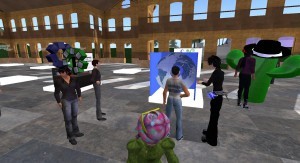 Expolab collaborates with the Tech Virtual Workshops in San Jose, California, awarded with the Linden Prize 2010 Expolab collaborates with the Tech Virtual Workshops in San Jose, California, awarded with the Linden Prize 2010
The Tech Virtual Museum Workshop has been awarded with the annual international Linden Prize 2010, a virtual space in which Expolab Citilab has made innovative contributions highly valued by both the San Jose museum itself and the organizers of the competition. The award is promoted by Linden Lab, creators of Second Life virtual world. The award was created by Linden Lab, the founders of the virtual world Second Life. The competition was tough, and Tech’s proposal was chosen from over 130 different projects. The award recognizes residents of Second Life or teams with $ 10.000 for innovative projects within Second Life to improve the way they work, learn and communicate in their everyday lives outside of this virtual world.
A more participatory exhibition spaces
The project Expolab has collaborated closely with the Tech Virtual Museum by creating a new concept of participatory exhibition where designers around the world have submitted prototypes that will become a corporeal exhibition in Citilab. The best projects were chosen on April the 8th by public voting online and offline (114 votes), both in our country and tin he USA with few hours difference.
These contributions have surprised the jury and have contributed in favor of the Tech proposals. Expolab was the first of its virtual workshops open to the participation of the all the cubes which made up the exhibition (and not just a single module, as before) and, moreover, that the winning projects were chosen by an open poll, instead of being chosen by a selected committee.
At the moment, we have already chosen the contents collectively through workshops and meetings with more than 60 people, co-created modules exhibition in Second Life with contributions from people of all ages and regions of the world, chosen the most popular modules by voting online and offline, worked on the final design,. So now we have to start building and transfering to the physical world, this exhibition that has been created in the virtual world with the participation of people worldwide. It is time to start thinking about how to co-create workshops and tours for visitors who will develope the activities they want and need to enjoy this exhibition.
Institutional recognition
However, this is not the only news related to Expolab. These days we know that this project has been selected for the meet program grants from the Spanish Foundation for Science and Technology (FECYT), among more than 2.000 nominations. Good news, wich certainly will encourage this project and consolidate and develop new ones in the field of science and technology communication.
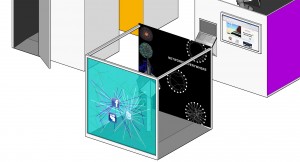 During the months of April and May, Expolab team has been working hard on getting the final design of the first exhibition “From the contemplation of participation, and beyond.” Our starting point was the modules chosen by the general public: Connections, photography, digital sky, the bank of ideas and what is your opinion about security, and from there, we have worked on the details and the homogeneity of the whole exhibition. During the months of April and May, Expolab team has been working hard on getting the final design of the first exhibition “From the contemplation of participation, and beyond.” Our starting point was the modules chosen by the general public: Connections, photography, digital sky, the bank of ideas and what is your opinion about security, and from there, we have worked on the details and the homogeneity of the whole exhibition.
This is an idea of the how the seven modules will look:
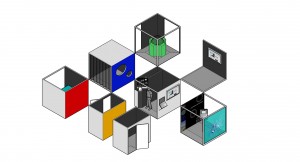
From now on we will start the construction work, and finally, we will see how the contribution of many people is embodied in a physical exhibition!
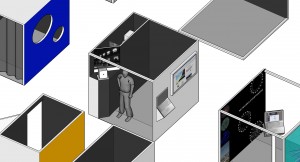 However, do not think that participation has come to an end, there are still many stages where we need ideas, requests, suggestions of all the people who are following this project. We will let you know all the activities we are planning in order to develope activities, courses and events around this exhibition as soon as we know the dates… However, do not think that participation has come to an end, there are still many stages where we need ideas, requests, suggestions of all the people who are following this project. We will let you know all the activities we are planning in order to develope activities, courses and events around this exhibition as soon as we know the dates…
The opening day is getting closer and that makes us be very exited… At the moment, we can celebrate that we have a final design!
Last May 13th the last workshop (for now) in the series about 2.0 practices for cultural institutions, part of the Citilab-Expolab/CCCB-Lab collaboration took place in Citilab.
We went through the process of inviting participants to reflect while doing. That is, to build their own prototypes of possible participatory projects in their institutions (or outside them) and start a design iteration that included role playing, scenario building and discussion.
Global screen: 10 windows to the world
A project that is scheduled to exhibit for 2011.
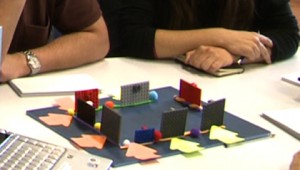 It aims to put in evidence the power of screens in contemporary society.
The screen as an interface that connects to the world.
This is part of an online and offline exhibition revolving around different types of screens: It aims to put in evidence the power of screens in contemporary society.
The screen as an interface that connects to the world.
This is part of an online and offline exhibition revolving around different types of screens:
- The screen as a manifesto or the political screen.
- The game screen (entertainment-oriented and educational among children).
- The social screen (the visual interface as an agora)
and so on.
The exhibition will consist of a journey through a continuous screen.
The pieces will be comissioned to video artists and artists in this field.
Also, it will be open to people so that they can create materials to be integrated in the exhibition.
Visitors to the site or internet users will be able to add personal interventions and build their own reflections on them.
These will be linked thematically to the type of screen that corresponds to the reflection either because they are confronting the screen created by and artist or reinforcing it, the user contribution being an example of what is meant by the artist. It will also open a dynamic web platform that will receive content before the exhibition opening.
At the same time, the exhibition raises the possibility that the contents can continue to evolve once the offline exhibition closes.
The main screen in the physical space will portray images of the visitors/participants taken from different angles while they are still visiting, so that participants can reflect about privacy.
I have a show at Caixaforum
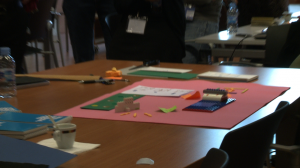 The goal is difussion, i.e., to generate public attraction and actual visits to an exhibition, and thus “build up brand” for the cultural center.
We propose a contest that will be accompanied by traditional advertising as well as 2.0 campaigns on social networks, etc.
It may invite uploading pictures or videos on YouTube, pieces of music, etc.. It will not require to use a specific artistic format.
Users will be able to vote for the pieces. This voting can take place through the usual online communication channels.
A jury or a similar institution will select the works presented, which will be eventually exhibited at an exhibition center.
Different types of awards will be established
. Also, the winners will be encouraged to participate in a workshop explaining their experience as well as the ideation and creation process of their piece. The goal is difussion, i.e., to generate public attraction and actual visits to an exhibition, and thus “build up brand” for the cultural center.
We propose a contest that will be accompanied by traditional advertising as well as 2.0 campaigns on social networks, etc.
It may invite uploading pictures or videos on YouTube, pieces of music, etc.. It will not require to use a specific artistic format.
Users will be able to vote for the pieces. This voting can take place through the usual online communication channels.
A jury or a similar institution will select the works presented, which will be eventually exhibited at an exhibition center.
Different types of awards will be established
. Also, the winners will be encouraged to participate in a workshop explaining their experience as well as the ideation and creation process of their piece.
The process would be as follows:
- Classical unidirectional campaign in traditional media
- Viral/Participatory Campaign inviting to participate in the contest
Some important aspects
- Diversity: each work is accompanied by certain personal data which will help in distributing the prizes among different user profiles.
- Aggregation of the works: a system for sending, rating, receive and evaluate the submitted information
- Workshop: by which users will discuss the process of creating the pieces, and help in the redefinition of the event for the following year.
Theatre 2.0
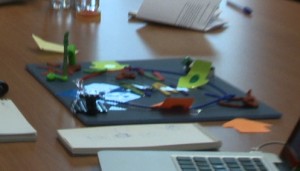 A play that starts from scratch, based on an initial survey about what matters to people as spectators.
That survey is organized from Twitter and Facebook asking for keywords that define the theme of the theatrical work.
Interviews and surveys at street level are also used, specially for users who do not have Internet access or do not use it.
In social networks questions are also posed and / or possible views with inputs such as news, photos, or other aesthetic props to stimulate response.
It therefore seeks to cause feedback on the process while integrating new keywords.
The seed keywords at the beginning are Twitter # hashtags used in networks close to the people that drive the initiative.
After collecting data on the most interesting topics and contents an script outline of a play is made.
The theatrical work is organized with co-writing partners, and it is presented in a real theatrical venue and broadcasted by videostreaming.
It is open to decide if the performance can also be “open” in real time while acting (either in person by the viewers at the theater or via online channels).
In order to publicize the work all the social capital generated during the creation of the outline and the co-creation of the script will be used. The feedback after the performance, personal assessments, etc. will be also collected and shared.
The profile of users involved in the survey, as well as writers and actors, could allow people to get into the learning process or even act as “spontaneous” or amateurs.
It can also be a valid project to recruit new talents. A play that starts from scratch, based on an initial survey about what matters to people as spectators.
That survey is organized from Twitter and Facebook asking for keywords that define the theme of the theatrical work.
Interviews and surveys at street level are also used, specially for users who do not have Internet access or do not use it.
In social networks questions are also posed and / or possible views with inputs such as news, photos, or other aesthetic props to stimulate response.
It therefore seeks to cause feedback on the process while integrating new keywords.
The seed keywords at the beginning are Twitter # hashtags used in networks close to the people that drive the initiative.
After collecting data on the most interesting topics and contents an script outline of a play is made.
The theatrical work is organized with co-writing partners, and it is presented in a real theatrical venue and broadcasted by videostreaming.
It is open to decide if the performance can also be “open” in real time while acting (either in person by the viewers at the theater or via online channels).
In order to publicize the work all the social capital generated during the creation of the outline and the co-creation of the script will be used. The feedback after the performance, personal assessments, etc. will be also collected and shared.
The profile of users involved in the survey, as well as writers and actors, could allow people to get into the learning process or even act as “spontaneous” or amateurs.
It can also be a valid project to recruit new talents.
e-learning school
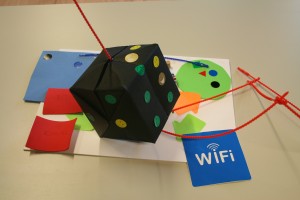 It proposes as a training school based on online participation. It
comprises three zones or areas: a virtual classroom with original content, an area used for dumping or recycling, and (most important) a methodology and tools for participation.
Users of the project are teachers, promoters, students and companies (the latter are permitted to make case studies).
The contents of the courses change every day, thanks to the contributions and participation of users.
The key is finding the motivation to generate content among all, especially case studies in business.
This virtual education is based on network profiles and thematic interests and portfolios and content generated by each user / participant.
We propose also a section for trainers to post their content, but could also be students who do it
Another key issue related to the project is to locate the information that should be categorized hierarchically and / or folksonomies.
The repository should help sort reviews, teaching materials, examples, etc..
The challenge is that the contents are based on real case studies, to enable meaningful learning. It proposes as a training school based on online participation. It
comprises three zones or areas: a virtual classroom with original content, an area used for dumping or recycling, and (most important) a methodology and tools for participation.
Users of the project are teachers, promoters, students and companies (the latter are permitted to make case studies).
The contents of the courses change every day, thanks to the contributions and participation of users.
The key is finding the motivation to generate content among all, especially case studies in business.
This virtual education is based on network profiles and thematic interests and portfolios and content generated by each user / participant.
We propose also a section for trainers to post their content, but could also be students who do it
Another key issue related to the project is to locate the information that should be categorized hierarchically and / or folksonomies.
The repository should help sort reviews, teaching materials, examples, etc..
The challenge is that the contents are based on real case studies, to enable meaningful learning.
Hiker Association
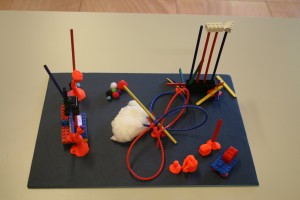 An open platform that serves to promote and relaunch an mountain hiking association which currently has a low activity.
Reasons? Generation gap and a lack of knowledge sharing with new people who approach the association with the intention of joining as a member.
The project tries to transcend the limitations of face to face meetups for outdoor hikes.
It should have a bank of resources and tools as well as tutorials on hiking for beginners.
It would also show how to take advantage of content based on the knowledge of the territory.
The possibility of geolocating itineraries and, thus, enhance the sharing of routes, ideas and favorite locations is also envisaged An open platform that serves to promote and relaunch an mountain hiking association which currently has a low activity.
Reasons? Generation gap and a lack of knowledge sharing with new people who approach the association with the intention of joining as a member.
The project tries to transcend the limitations of face to face meetups for outdoor hikes.
It should have a bank of resources and tools as well as tutorials on hiking for beginners.
It would also show how to take advantage of content based on the knowledge of the territory.
The possibility of geolocating itineraries and, thus, enhance the sharing of routes, ideas and favorite locations is also envisaged
If you want to see more photos from this event, you will find them in Flickr!
On May 6th we made the third workshop on “Project 2.0. Practices for cultural institutions”, organized by the Centre for Contemporary Culture (CCCB) and the Citilab. This time it was Citilab, in Cornellà. Again, some thirty participants shared their knowledge and their desire to finish defining six groups of two to eight people. These groups worked on the creation of prototypes with cardboard, Lego, Plasticine … to finish defining a participatory project. Throughout the day, these prototypes were the seed that sparked great debate, which raised conflict, which led to consider some steps to take or to propose a reflection on the motivations for introducing citizen participation in the practices of cultural institutions our environment.
The structure was participatory, had the cooperation of all attendees, led to the co-design and strategies used … We could say that the workshop itself was itself an act 2.0 which also wanted to go beyond the 6 hours collective work, creating a working group on-line for further discussion and analysis of the hows, whys, whys who and participation.
The projects proposed by this group were the following:
Art at Home
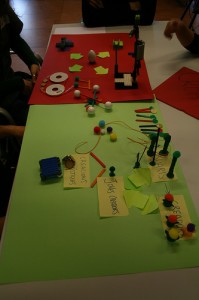 Bringing art home to democratize art and promote new artists. Bringing art home to democratize art and promote new artists.- Self-managed platform for young artists, NGOs or Cooperative collectives, where you pay a registration fee. It is also contemplated that the artist can pay a service contracted out for the alternative to the fixed, or that the whole project can work as a cooperative or bank time.
- It will request for proposals for home interventions or artistic events.
- Platform acts as an intermediary and facilitator / channel of supply and demand for such services.
- Suitable for all types of art (music, theater, dance, performance, painting, video, etc).
- Can obtain feedback on the service request posted with a structure similar to Digg, in order to encourage word of mouth spreading.
- If offers the possibility of being able to involve the “public” actions / works, depending on the artist.
What are you doing?
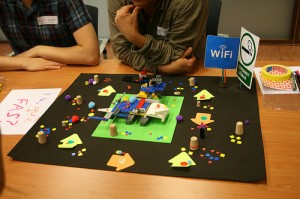 Project to encourage socialization. Open space to offer / propose cultural activities by citizens. Project to encourage socialization. Open space to offer / propose cultural activities by citizens.- It is also an inspiration Center that aims at causing the reaction or mood change for users.
- Presence of music, painting, dance, facilities, computers, internet …
- It allows to work individually or with more people, “encouraged” by the theater.
- People come close to it, out of curiosity, making an artistic journey that leads them to a change of mind.
- It seeks a transformation of people into the spirit / creative way.
- It has an urban location, around a particular school or center of activities.
- It is proposed that it can be managed by a public-private consortium, or sponsored by a company as part of a code of corporate social responsibility.
- After interacting with the contents, citizens may propose new contents, which would led to activating new contacts.
- Eligibility to register / sign in person or via the web.
The philosophy of the project is to influence the citizen to make him/her think and change his/her roles.
People’s maps
 Geolocation platform to promote awareness among local people and to break distances between neighbours whether they are artists or not. Geolocation platform to promote awareness among local people and to break distances between neighbours whether they are artists or not.- Easy interface that allows users to submit video and geolocate it in the city.
- Sewlfpromotion would help cultural and artistic offers but also social or business initiatives in the neighbourhodd.
- It also would have a synchronous communication layer via Skype or similar.
It would include voting systems to help assess content.
- It allows the creation of routes to meet and get people togehter and relate them to upcoming initiatives.
- Mashup tool: Google maps API, content rating, Skype or similar.
- Would create a documentary archive of the city that would help in finding content of institutions or entities.
- It could also be extended in person or by means adhesives to QR codes that link the physical locations with digital map.
“Macba” 2.0
 Participatory refoundation of an existing museum to reflect the participation as of interest to contemporary society. Participatory refoundation of an existing museum to reflect the participation as of interest to contemporary society.- It also tries to generate knowledge in a participatory manner and to reafirm its public nature and therefore this knowledge should be shared.
- Allows the aggregation of opinions, ideas, proposals about the institution and its activities.
- Promotes evolvving from an static to an emerging institution based on creative chaos.
- The user raises or “meddles” in the processes that defines the internal and external operation of the center.
Example proposals of initiatives and processes:
- Bonding with companies
- More user feedback> institution> artists
- Possibility of accommodating snacks and drinking in the exhibit spaces
- Allow the redesign of the exhibition spaces
- Possibility to use copyleft licenses on works
- Space for self-managed exhibitions
- Guided tours with the artists themselves
- Score on shows or complete works
- Database with keywords on each work
- Support to new artists and partnerships
- Playing space for adults and children
- It is open to gamers as a group with creative potential
- It generates financial resources to gain independence
- Open online presence to promote comment
- The essence is to turn the museum into an art center
“Who is an artist and who is not?”
 Virtual classroom project to generate debate on copyright. Virtual classroom project to generate debate on copyright.- It starts from the distinction between “prosumers” and artists to compare their type of work and interventions.
- It puts into crisis the notion of authorship of artistic works.
Process:
• Generated / captured copyleft licensed works of artists
• It also on works created by the citizens themselves
• Many allowed formats: painting, sculpture, photography, video, etc.
• Works are exchanged bewteeen the “plain citizens” and the “artist” groups and each group works are given to the other group so that they can modify each other’s work in turns
• The results presented are virtual
• It also promotes reflection on the very concept of authorship.
• It raises the possibility that a third party could sell even with copyleft.
• The DJ as a metaphor for remixing and remaking content.
• The works can be changed both in person and online.
• It also promotes works that can go through different formats.
• It integrates the idea of holding regular meetings of intensive modification of the work.
The work is alive and in that sense never “completed”.
Technological Atheists
 It is a project that aims to promote active participation and critical debate around the fact of people being deciding whtehter to be always connected, or not. It is a project that aims to promote active participation and critical debate around the fact of people being deciding whtehter to be always connected, or not.- A has a platform that allows to locate, view and connect with the “digital disconnected” people and their motivations for staying so.
- I will be done in both the most developed countries and in the less developed countries.
- It involves a trip around the world to detect cases in different places in terms of their cultural, political and economic diversity.
- A reporter with GPS information of Internet users keeps on locating people without Internet, cell phones or access to other Information Techologies.
- It uses a blog to report on steps taken to locate and interview the “disconnected person”.
- Each interviewee expresses what it means to be disconnected.
- The “public” on the other side (via internet) gives its opinion on whether that person should be connected or not.
- It aims to open the discussion to exchange opinions on the interest and / or need to “connect” to certain people.
- The project may end in a story or audiovisual product design.
- It could be sponsored by mobile phone companies or similar given that there would be extensive qualitative studies on the field.
If you want to see more photos from this event, you will find them in Flickr!
On April 22nd, Irene Lapuente, Ramon Sangüesa from the Expolab team at Citilab and Enric Senabre (coordinator of Urbalanbs at Citilab) facilitate the first of a series of four workshops on practices 2.0 in cultural institutions. This first workshop took place at CCCB, Barcelona Center for Contemporary Culture.
In six very intense hours, communication, media, and museum professionals, got a hint of what it takes to develop a full-fledged 2.0 participatory project. First, they were asked to imagine and prototype projects in a very short time. All of them had to include a greater or lesser degree of participation.
In general, the prototypes showed concern about participatory relationships with users. Most of these users were “artists”, although some participants in the workshop also opened participation to plain citizens.
Once the project prototypes were built using cardboard, plasticine, sticks and stickers, participants were divided into groups taking the roles of users or, alternatively, presenters of their projects. That gave people a taste of what it takes to be on the user’s shoes and to understand what they really want and what is their view when they are invited to participate.
The afternoon brought in more reflections about the projects: What was the best thing that could happen to a project? And what was the worst? How the worst scenario could be avoided and what other steps should be followed?
Finally a strong point was made by asking directly why people wanted to include participation in their projects? Which were their objectives as an institution and how it was going to get any benefit from a participatory approach? All these questions led to a strongdebate … that had to end for the time being at CCCB. However, it will continue online at the working group formed by all the people that took part in the four workshops of the series aobut 2.0 practices in cultural institutions.
Here are the project proposals that emerged during the first workshop:
EmoLab
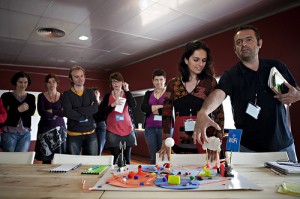 An exhibition centre for emotions aimed at every type of public. An exhibition centre for emotions aimed at every type of public.- Focussing around the channeling of emotions, with entry devices such as videoanimation to record users.
- Importance of the “hook” and how to get people into the centre.
- Containing both a virtual part or “cloud” in order to generate content and the level of committment from the participants in the project.
- It would evoke through experiences, regardless of classic artistic classifications (theatre, dance, painting, etc).
- Online socializing would be strengthened thanks to “digitalization” of the examples of emotions.
- Possibility to trnsfer it to other areas and spaces, peripatehtically, strengthening the experience of attendance.
Public project for consuming and co-creating art
 A physical space for creators to launch their own works to the public. A physical space for creators to launch their own works to the public.- Conceived as a public space, not just an installation.
- However, it would be a physical reference and workspace.
- Importance of the stewardship: the proposal would include a cultural administrator acting as a facilitator.
- Criteria for selecting works: committees would also integrate the users, the public.
- The programmer/director should act more as a mediator than as a director.
- It would reposition the institution, which as an added value would seek to involve the user.
- It would strengthen collective art projects, making them known to a wider public from the same single platform.
- Thanks to activating a critical mass of users / decision-makers the quality and interest of the projet and works wil be made credible.
- It is a type of cultural centre operating “à la carte”, which has presence on the streets and adjacent spaces.
The voice from the square
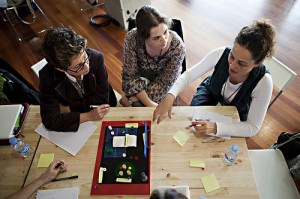 Peripathetic project of cultural heritage aimed at different audiences and ages. Peripathetic project of cultural heritage aimed at different audiences and ages.- Starting with a type of empty bucket into which participants can add content.
- A series of “mailboxes” will collect and digitalize experiencies around the public space of the participants.
- Examples are compiled around local heritage and identity (photos, voice, video, text).
- It even integrates conflict showing it as a living-dialogue between the exhibition and the public.
- The content is accessible via specific digital tables, from where it can be remixed.
- As the exhibition travels around it accumulates material and invites a reaction to it.
- It incorporates a physical outside meeting-space for participants.
- The exhibition should reach local collectives before it “disembarks”.
- Later on it promotes and reflects everything on-line, including an ethnographic study about the information compiled.
Community of social projects
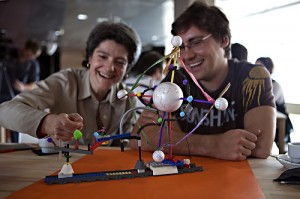 An area for dropping in and exchange for experts and all those interested in different environments. An area for dropping in and exchange for experts and all those interested in different environments.- It can range from rural museums, to photo exhibitions, from NGO’s to journalist groups (professionals and citizens).
- A metacommunity for projects, to share motivation, resources, common aims, etc.
- It fosters voluntary applications around the projects under development.
- It create a working social network of people and ideas, for remixing (for example journalism and catalan literature).
- It would integrate initially content from experts in other networks and prestigious places, as motors for each group.
Cultural Laboratory online
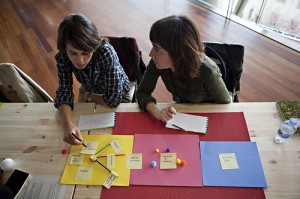 An online network of users who mutually help themselves to create works. An online network of users who mutually help themselves to create works.- Moderated and fllowed closely by a curator.
- it is a platform for artists, and users are able to contribute or act as observers.
- It is a living organism regardless of time-limitations that are typical for exhibitions.
- The virtual platform would incorporate tools for decision making.
Hybrid Platform for artistic production
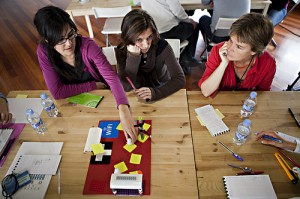 A physical space serving as a node for centres of artistic production. A physical space serving as a node for centres of artistic production.- A virtual space as an idea factory for different agents.
- It aims at strengthening dynamics and interaction of different profiles.
- Dilemma on whether to create a brand new online platform vs. appropiating already existing ones
- Aiming to put the final user in contact with the creatives.
If you want to see more photos from this event, you will find them in Flickr!
All photos copyright CCCB / Carlos Cazurro
The second workshop, “2.0 Projects and practices in cultural institutions” organized by the Centre for Contemporary Culture (CCCB) and Citilab was held on April 28th in the Sala del Mirador at the CCCB. Again, a large number of participants got together to work and define six projects involving the participation of users.
Here are their proposals:
Archiu-us
-
 An area but also a conceptual map for revising the concept of a library. An area but also a conceptual map for revising the concept of a library.
- The user may access the production of the “official” cultural industry in multiple formats.
- Additionally, the user can produce and consume all users’ production.
- It is a structure on the net, where everybody can have access to its content
- The role of the library is to offer tools and facilitate more active roles.
- For example, materials are stored related to personal memory (personal testimonies).
- Seeking to construct a community where the library has an active role in improving its materials.
- As a physical space it has ana are for cataloguing and accessing content and another one for production of content.
- The cataloguing (also participative) would be organized by using an open subject list and keywords.
- A model of copyleft licences for users’ works with different options would be used.
I-lab (laboratory of Ideas)

- A virtual Project open to institutions and individuals for spreading ideas.
- Any institution can take their “needs” to link them and work on them.
- A facilitating area based on tagging ideas.
- It pursues the goal of “democratizing” culture and to collaborate with its environment.
- It would enable ideas and people who are currently disconnected to be grouped together.
- Uusers can bring in projects in which they wish to work.
- Despite being virtual it could also have a physical space or reference.
- It is devised mainly to act only as a connector, with no subsequent follow up of what comes out of it.
“Be the expo”
 Project to make scientific learning more participative, where the user feels part of the process. It offers two possibilities for participation: Project to make scientific learning more participative, where the user feels part of the process. It offers two possibilities for participation:
- A dynamic process for choosing collectively the subject-areas for the exhibition.
- Concrete Identification of aspects to exhbit in the chosen subject-area.
- In both cases we take a look at what is filtered through the criteria of experts.
- The users are consulted about how the exhibition should be articulated.
- People are invited during the process to learn and be more active in the subject-area under consideration.
- One can interact on-line by modyfing from home the objects and elements exhibited.
- The exhibition can be modified during the participation process.
- Not only do we promote opinion, but we actively modify what happens in terms of personal presence.
- The exhibition is strengthened because it has an online discussion and reflection area outside the reach of the museum or institution that hosts the physicial exhibitions.
- Dynamic processes are promoted to “protagonize” elements of the exhibition (in virical simulations for example).
Traffic
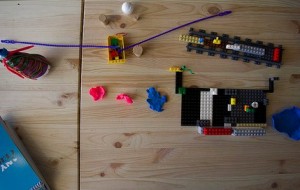
Project to be located in low transing areas: waiting areas, hubs, the global “non-places”.
It developds in three phases:
- Communication with a diverse audience using these “non places”: open questions about what use to give this space are posed there.
- Design of a concrete installation in the space that responds to the requests.
- Celebration of events, actions, exhibitions, concerts, based on the inputs received from users.
Example: the waiting-hall and passageway in Terminal 1 at Barcelona airport
- it is a place where users can decide what is going on in terms of cultural experience.
- The area would be filled with content promoted and generated online or in person.
- The user can add content and suggestions or be just a mere spectator.
- It could, for example, be a platform for emerging creators, who base their ideas around proposals given by users.
- A virtual idea board would be set up to participate from distance or in person, in advance or in situ.
- At an economic level it could be opened to commercial sponsors, or promoted as an opportunity to give added value to the space for the manager of that transit space.
Open door
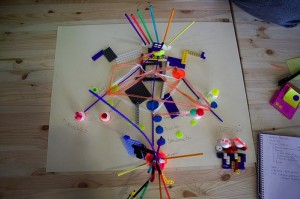
- Online project facilitating connections between youn creators and promoting them, acting as a launching pad for young creators.
It proposes three lines of action:
- Training: access to knowledge for artistic and cultural creation based on transversal dynamics of sharing between users, on the one hand, and, on the other, by experts in specific aspects that act as consultants for creators.
- Promoting actively the motivation and facilitation of productions. The platform here serves as a channel for networking and distribution of expert advice.
- Publicising the works created via a web presence and networks of contacts that grow around the platform.
- There is also a plan for an functional area for those professionals in charge of run galleries as well as experts so that they can detect talent via access to the platform.
- it will also work as a motivational element with emphasis on learning, on the one hand, and on the other recognition for contributions.
The first kiss
-
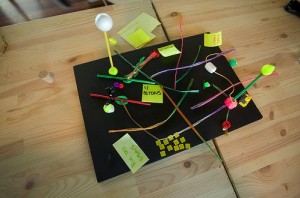 Project based on the possibilities of participation around personal stories about the first kiss Project based on the possibilities of participation around personal stories about the first kiss
- This is used as an example proposal, but it aims in general to the goal of achieving cultural ressonance from projects built around vital experiencies
- It aims to provoke and promote things to happen public areas
- In this case, it could start at the well known “Carrer dels Petons” (Street of Kisses) in the gothic quarter of Barcelona
- It would use a video-photo-booth where people could explain their first love by telling anecdotes about the experience of their first kiss
- People can invited or be invited to enact this first kiss. Also, famous first kisses on history of cinema can be used.
- Street sings would be set up to identify and locate the initiative.
- A webpage would publish the content, and would also be visible from the place where people sign up.
- The project aims to detonate experiences, spark significant action.
- It is open to all ages, as well as in its use to connect with personal stories.
- Project and platform should be designed so that they can be used for other similar experiences.
If you want to see more photos from this event, you will find them in Flickr!
Due to the great interest amongst cultural institutions in the two previous workshops on participatory 2.0 strategies held at the CCCB (22nd & 28th April), Citilab hosted on May 6th the first of two more sessions. The second was on Thursday, May 13th.
You can follow the corresponding tweets here:
During the months of April and May, Expolab team is working hard to make the most votes prototypes generated digitally in a virtual world like Second Life. The idea is to create an exhibition that makes a short tour on the science, the technology and the humanity behind the changes that Internet and new technologies has generated in our lives. However, we want to build an exhibition with more than one way of reading it and we will ask visitors to propose their personal route and even to tell us how they would use the space for creating activities and workshops around this contents.
We show you some images of this process and we look forward to hearing from you!

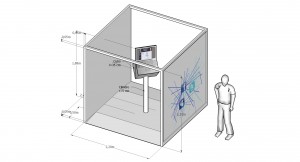
|
|
 Today, The Tech Museum president, Dr. Peter Friess, officialy opened the exhibition “The Tech Challenge Gallrey”. This exhibition shows to new visitors, more than forty totally interactive experiments prepared, narrated and explained by other visitors: boys and girls that have collaborated in this gallery explaining experiments on video.
Today, The Tech Museum president, Dr. Peter Friess, officialy opened the exhibition “The Tech Challenge Gallrey”. This exhibition shows to new visitors, more than forty totally interactive experiments prepared, narrated and explained by other visitors: boys and girls that have collaborated in this gallery explaining experiments on video. Finally, other new visitors will be able to experiment and understand science thanks to the videos recorded by other previous visitors: the girls and boys we have alreadya mentioned. Everyone, eventually could become the start of the “Tech Challenge Gallery”, because this is a process that is alive and well and will be kept going by all people involve, staff and visitors alike.
Finally, other new visitors will be able to experiment and understand science thanks to the videos recorded by other previous visitors: the girls and boys we have alreadya mentioned. Everyone, eventually could become the start of the “Tech Challenge Gallery”, because this is a process that is alive and well and will be kept going by all people involve, staff and visitors alike. This exhibition, however, is not only for kids. Adults can also enjoy it. The Expolab Team (Irene Lapuente and Ramon Sangüesa) have been there too and enjoyed playing with wheel gears, peg tops and prisms. We think that this kind of initiatives help not just to bring science close to people but also let the younger ones appropriate by science themselves. Congratuilations to the Tech!
This exhibition, however, is not only for kids. Adults can also enjoy it. The Expolab Team (Irene Lapuente and Ramon Sangüesa) have been there too and enjoyed playing with wheel gears, peg tops and prisms. We think that this kind of initiatives help not just to bring science close to people but also let the younger ones appropriate by science themselves. Congratuilations to the Tech!

 Expolab collaborates with the Tech Virtual Workshops in San Jose, California, awarded with the Linden Prize 2010
Expolab collaborates with the Tech Virtual Workshops in San Jose, California, awarded with the Linden Prize 2010


 It aims to put in evidence the power of screens in contemporary society.
The screen as an interface that connects to the world.
This is part of an online and offline exhibition revolving around different types of screens:
It aims to put in evidence the power of screens in contemporary society.
The screen as an interface that connects to the world.
This is part of an online and offline exhibition revolving around different types of screens: The goal is difussion, i.e., to generate public attraction and actual visits to an exhibition, and thus “build up brand” for the cultural center.
We propose a contest that will be accompanied by traditional advertising as well as 2.0 campaigns on social networks, etc.
It may invite uploading pictures or videos on YouTube, pieces of music, etc.. It will not require to use a specific artistic format.
Users will be able to vote for the pieces. This voting can take place through the usual online communication channels.
A jury or a similar institution will select the works presented, which will be eventually exhibited at an exhibition center.
Different types of awards will be established
. Also, the winners will be encouraged to participate in a workshop explaining their experience as well as the ideation and creation process of their piece.
The goal is difussion, i.e., to generate public attraction and actual visits to an exhibition, and thus “build up brand” for the cultural center.
We propose a contest that will be accompanied by traditional advertising as well as 2.0 campaigns on social networks, etc.
It may invite uploading pictures or videos on YouTube, pieces of music, etc.. It will not require to use a specific artistic format.
Users will be able to vote for the pieces. This voting can take place through the usual online communication channels.
A jury or a similar institution will select the works presented, which will be eventually exhibited at an exhibition center.
Different types of awards will be established
. Also, the winners will be encouraged to participate in a workshop explaining their experience as well as the ideation and creation process of their piece. A play that starts from scratch, based on an initial survey about what matters to people as spectators.
That survey is organized from Twitter and Facebook asking for keywords that define the theme of the theatrical work.
Interviews and surveys at street level are also used, specially for users who do not have Internet access or do not use it.
In social networks questions are also posed and / or possible views with inputs such as news, photos, or other aesthetic props to stimulate response.
It therefore seeks to cause feedback on the process while integrating new keywords.
The seed keywords at the beginning are Twitter # hashtags used in networks close to the people that drive the initiative.
After collecting data on the most interesting topics and contents an script outline of a play is made.
The theatrical work is organized with co-writing partners, and it is presented in a real theatrical venue and broadcasted by videostreaming.
It is open to decide if the performance can also be “open” in real time while acting (either in person by the viewers at the theater or via online channels).
In order to publicize the work all the social capital generated during the creation of the outline and the co-creation of the script will be used. The feedback after the performance, personal assessments, etc. will be also collected and shared.
The profile of users involved in the survey, as well as writers and actors, could allow people to get into the learning process or even act as “spontaneous” or amateurs.
It can also be a valid project to recruit new talents.
A play that starts from scratch, based on an initial survey about what matters to people as spectators.
That survey is organized from Twitter and Facebook asking for keywords that define the theme of the theatrical work.
Interviews and surveys at street level are also used, specially for users who do not have Internet access or do not use it.
In social networks questions are also posed and / or possible views with inputs such as news, photos, or other aesthetic props to stimulate response.
It therefore seeks to cause feedback on the process while integrating new keywords.
The seed keywords at the beginning are Twitter # hashtags used in networks close to the people that drive the initiative.
After collecting data on the most interesting topics and contents an script outline of a play is made.
The theatrical work is organized with co-writing partners, and it is presented in a real theatrical venue and broadcasted by videostreaming.
It is open to decide if the performance can also be “open” in real time while acting (either in person by the viewers at the theater or via online channels).
In order to publicize the work all the social capital generated during the creation of the outline and the co-creation of the script will be used. The feedback after the performance, personal assessments, etc. will be also collected and shared.
The profile of users involved in the survey, as well as writers and actors, could allow people to get into the learning process or even act as “spontaneous” or amateurs.
It can also be a valid project to recruit new talents. It proposes as a training school based on online participation. It
comprises three zones or areas: a virtual classroom with original content, an area used for dumping or recycling, and (most important) a methodology and tools for participation.
Users of the project are teachers, promoters, students and companies (the latter are permitted to make case studies).
The contents of the courses change every day, thanks to the contributions and participation of users.
The key is finding the motivation to generate content among all, especially case studies in business.
This virtual education is based on network profiles and thematic interests and portfolios and content generated by each user / participant.
We propose also a section for trainers to post their content, but could also be students who do it
Another key issue related to the project is to locate the information that should be categorized hierarchically and / or folksonomies.
The repository should help sort reviews, teaching materials, examples, etc..
The challenge is that the contents are based on real case studies, to enable meaningful learning.
It proposes as a training school based on online participation. It
comprises three zones or areas: a virtual classroom with original content, an area used for dumping or recycling, and (most important) a methodology and tools for participation.
Users of the project are teachers, promoters, students and companies (the latter are permitted to make case studies).
The contents of the courses change every day, thanks to the contributions and participation of users.
The key is finding the motivation to generate content among all, especially case studies in business.
This virtual education is based on network profiles and thematic interests and portfolios and content generated by each user / participant.
We propose also a section for trainers to post their content, but could also be students who do it
Another key issue related to the project is to locate the information that should be categorized hierarchically and / or folksonomies.
The repository should help sort reviews, teaching materials, examples, etc..
The challenge is that the contents are based on real case studies, to enable meaningful learning. An open platform that serves to promote and relaunch an mountain hiking association which currently has a low activity.
Reasons? Generation gap and a lack of knowledge sharing with new people who approach the association with the intention of joining as a member.
The project tries to transcend the limitations of face to face meetups for outdoor hikes.
It should have a bank of resources and tools as well as tutorials on hiking for beginners.
It would also show how to take advantage of content based on the knowledge of the territory.
The possibility of geolocating itineraries and, thus, enhance the sharing of routes, ideas and favorite locations is also envisaged
An open platform that serves to promote and relaunch an mountain hiking association which currently has a low activity.
Reasons? Generation gap and a lack of knowledge sharing with new people who approach the association with the intention of joining as a member.
The project tries to transcend the limitations of face to face meetups for outdoor hikes.
It should have a bank of resources and tools as well as tutorials on hiking for beginners.
It would also show how to take advantage of content based on the knowledge of the territory.
The possibility of geolocating itineraries and, thus, enhance the sharing of routes, ideas and favorite locations is also envisaged Bringing art home to democratize art and promote new artists.
Bringing art home to democratize art and promote new artists. Project to encourage socialization. Open space to offer / propose cultural activities by citizens.
Project to encourage socialization. Open space to offer / propose cultural activities by citizens. Geolocation platform to promote awareness among local people and to break distances between neighbours whether they are artists or not.
Geolocation platform to promote awareness among local people and to break distances between neighbours whether they are artists or not. Participatory refoundation of an existing museum to reflect the participation as of interest to contemporary society.
Participatory refoundation of an existing museum to reflect the participation as of interest to contemporary society. Virtual classroom project to generate debate on copyright.
Virtual classroom project to generate debate on copyright. It is a project that aims to promote active participation and critical debate around the fact of people being deciding whtehter to be always connected, or not.
It is a project that aims to promote active participation and critical debate around the fact of people being deciding whtehter to be always connected, or not. An exhibition centre for emotions aimed at every type of public.
An exhibition centre for emotions aimed at every type of public. A physical space for creators to launch their own works to the public.
A physical space for creators to launch their own works to the public. Peripathetic project of cultural heritage aimed at different audiences and ages.
Peripathetic project of cultural heritage aimed at different audiences and ages. An area for dropping in and exchange for experts and all those interested in different environments.
An area for dropping in and exchange for experts and all those interested in different environments. An online network of users who mutually help themselves to create works.
An online network of users who mutually help themselves to create works. A physical space serving as a node for centres of artistic production.
A physical space serving as a node for centres of artistic production. An area but also a conceptual map for revising the concept of a library.
An area but also a conceptual map for revising the concept of a library.
 Project to make scientific learning more participative, where the user feels part of the process. It offers two possibilities for participation:
Project to make scientific learning more participative, where the user feels part of the process. It offers two possibilities for participation:

 Project based on the possibilities of participation around personal stories about the first kiss
Project based on the possibilities of participation around personal stories about the first kiss

